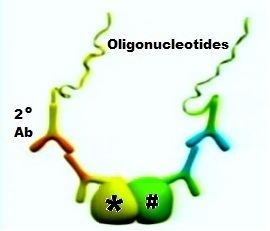 | ||
Proximity ligation assay (in situ PLA) is a technology that extends the capabilities of traditional immunoassays to include direct detection of proteins, protein interactions and modifications with high specificity and sensitivity. Protein targets can be readily detected and localized with single molecule resolution and objectively quantified in unmodified cells and tissues. Utilizing only a few cells, sub-cellular events, even transient or weak interactions, are revealed in situ and sub-populations of cells can be differentiated. Within hours, results from conventional co-immunoprecipitation and co-localization techniques can be confirmed.
Contents
The PLA principle
Two primary antibodies raised in different species recognize the target antigen on the proteins of interest. Secondary antibodies (2o Ab) directed against the constant regions of the different primary antibodies, called PLA probes, bind to the primary antibodies.
Each of the PLA probes has a unique short DNA strand attached to it, If the PLA probes are in close proximity (that is, if the two original proteins of interest are in close proximity, or part of a protein complex, as shown in the figures), the DNA strands can participate in rolling circle DNA synthesis when appropriate substrates and enzymes are added.
The DNA synthesis reaction results in several-hundredfold amplification of the DNA circle. Next, fluorescent-labeled complementary oligonucleotide probes are added, and they bind to the amplified DNA. The resulting high concentration of fluorescence is easily visible as a distinct bright spot when viewed with a fluorescence microscope. In the specific case shown, the nucleus is
enlarged because this is a B-cell lymphoma cell. The 2 proteins of interest are a B cell receptor and MYD88. The finding of interaction in the cytoplasm was interesting because B cell receptors are thought of as being located in the cell membrane.
Applications
PLA as described above has been used to study aspects of animal development and breast cancer among many other topics. A variation of the technique (rISH-PLA) has been used to study the association of protein and RNA.
